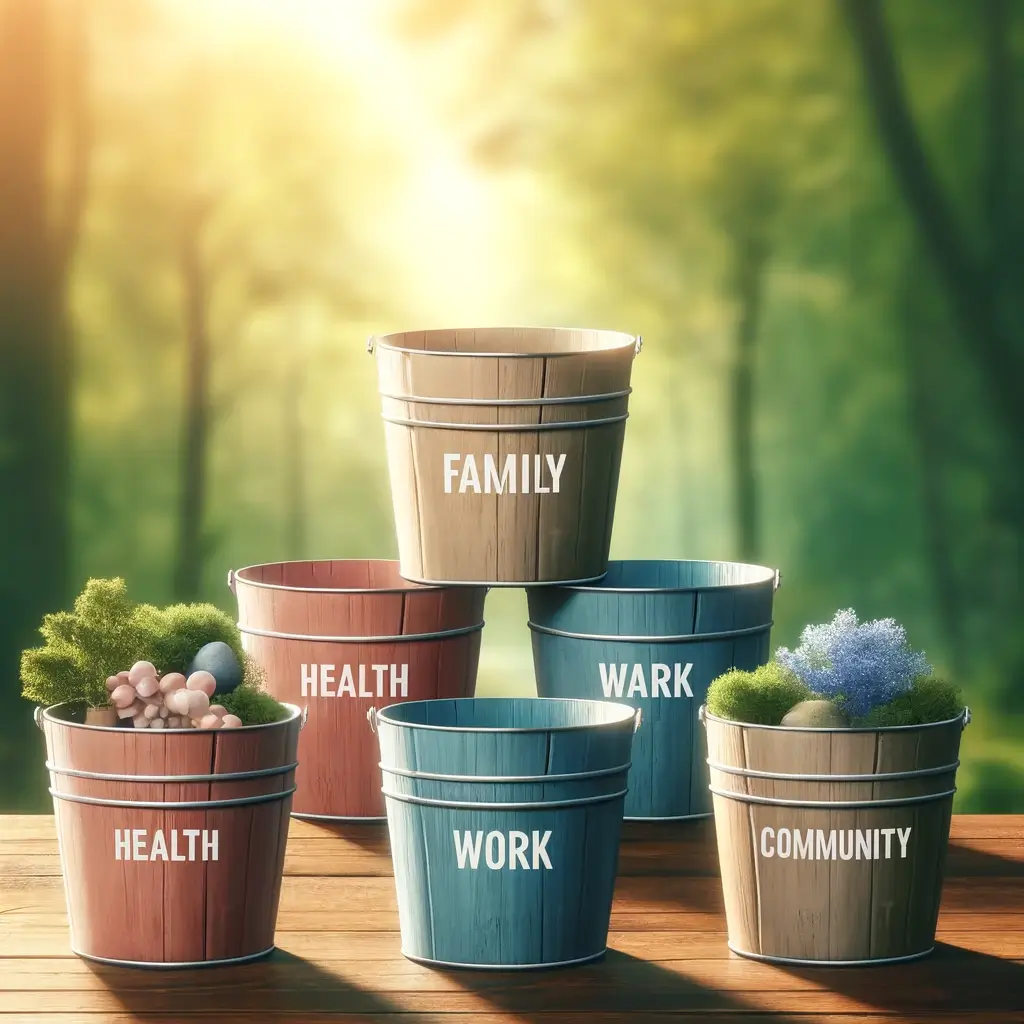All it takes is understanding what cutting-edge science reveals about how our brains function, adapt, and grow. Then, by implementing simple, science-backed practices and tracking your improvement, you can unlock your full potential.
Does this sound intriguing? If so, this article is for you. Let’s dive in and explore how these powerful insights can create a meaningful, lasting impact on your life. 🚀

This isn’t just motivational talk; it’s neuroscience in action. Recent advancements in brain science reveal why we struggle with destructive behaviours and how we can replace them with habits that fuel success and happiness. These solutions are simple, practical, and adaptable to any area of life you want to improve: family, health, work, community, or personal growth.
The best part? They work for everyone. You don’t need to overhaul your life overnight. Instead, by applying small, intentional steps grounded in theories like Predictive Processing (PP),Relevance Realization (RR), and the Zone of Proximal Development (ZPD), you’ll unlock steady, sustainable growth—no matter your starting point.

This article will show how these groundbreaking insights can help you:
- Break free from destructive habits.
- Thrive in life’s most essential areas.
- Achieve balance, purpose, and growth.
Ready to dive in? Let’s explore the science and practical steps to unlock your full potential. 🚀
🧠 The Science of Personal Growth

🧠 Predictive Processing (PP): The Brain’s Learning Model
Your brain is a powerful prediction machine, constantly forecasting what’s about to happen based on past experiences. This process, called Predictive Processing (PP), helps you navigate life efficiently by creating expectations. But understanding how it works—both when predictions go right and when they go wrong—can be a game-changer. 🌟
Good Predictions: The Feel-Good Loop 😊

When your brain’s predictions align with reality, it rewards you with positive emotions like joy and satisfaction.
Example:
- You try a new recipe, and it turns out delicious. 🍝
- Result: Your brain releases dopamine, reinforcing the behaviour and motivating you to take on new challenges.
Why It’s Powerful:
- Encourages exploration and growth.
- Builds confidence by showing effort leads to success.
Bad Predictions: The Learning Opportunity 🔄

When predictions fail, your brain generates an “error signal.” While this might feel unpleasant, it’s actually an opportunity to adapt and improve—or, if you can’t reframe it as a chance to grow, you may find yourself avoiding the error altogether.
Example:
You mess up the recipe (too much salt! 🧂).
Result: Your brain updates its prediction: “Next time, measure carefully!” ✅
Why It Can Be Transformative:
- 🔄 Turns failure into feedback.
- 🌱 Reframes mistakes as opportunities to learn and grow.
Why It Can Be Harmful if You Can’t Reframe It:
When you can’t reframe failure, it often becomes a source of fear and avoidance. Instead of seeing mistakes as a natural part of growth, you might view them as proof of your limitations. This can lead to:
- 😨 Paralysis by fear: Avoiding challenges or new experiences for fear of failing again.
- 🌱 Stunted growth: Missing opportunities to adapt, improve, and expand your skills.
- 💔 Negative self-perception: Internalising failure as a flaw in your character rather than a step toward progress.
Without reframing, the “error signal” becomes a barrier 🚧 instead of a bridge 🌉 to learning and transformation.
🎯 Relevance Realization (RR): How Your Brain Focuses on What Matters

Relevance Realization (RR) is your brain’s incredible ability to filter out distractions and hone in on what’s truly meaningful. It’s the process that helps you prioritise tasks, make sense of your environment, and focus your energy on what really matters. 🌟
How Relevance Realization Works
- The Brain’s Filtering Mechanism 🧠
○ Your brain is bombarded with endless stimuli—sounds, sights, thoughts, and more.
○ RR acts like a mental filter, deciding what to focus on and what to ignore.
- Example: You’re in a noisy coffee shop, yet you can focus on the conversation with your friend while ignoring the background chatter. ☕👂
- Prioritising Meaningful Tasks 🗂️
○ RR helps you zero in on actions and decisions that align with your goals and values.
○ Example: When faced with a long to-do list, RR naturally nudges you to complete the tasks that feel most pressing or impactful.
Now that we know what today’s cutting-edge science reveals about how our brains work and develop, let’s dive into a practical framework anyone can use to improve at anything in life.
The Solution: Welcome to The 5-Bucket Challenge! 🎉

The 5-Bucket Challenge is a science-backed practice designed to help you identify the five most important areas of your life and set intentional practices for each. By applying cutting-edge scientific insights and adopting a gradual, sustainable approach, you can cultivate greater fulfillment, meaning, and connection in your daily life.
But before we dive in, it’s important to remember: none of us are perfect, and things won’t always go to plan. Here’s how to approach the challenge effectively:
-
Start Small 🌱
Begin with one manageable action in each bucket. This ensures you’re not overwhelmed and can celebrate quick wins along the way. -
Grow Steadily 📈
Gradually build on your efforts by taking on slightly bigger challenges, staying within your “Goldilocks zone” for growth—neither too easy nor too hard. -
Reset with Ease 🔄
If you falter, don’t stress. Pause, reassess, and restart with smaller steps. Life happens, and what truly matters is consistency over time.
1. Family 👨👩👧👦: Building Strong Connections
We all want to thrive and feel deeply connected with our family, but this takes practice. In today’s busy world, if we don’t set aside focused time for family and intentional engagement, we risk losing the strong connections that mean so much to us.

By setting the intention to truly connect with people—instead of defaulting to watching TV or scrolling on our phones—you can create a profoundly positive impact on your life. Genuine connection makes us feel more positive, engaged, and valued.
On the flip side, distractions like constant screen time can take a serious toll on one of the most valuable areas of our lives: our relationships. Prioritising presence over distractions strengthens bonds and brings deeper meaning to our interactions
A great example of intentional connection is a family meal, practised once or twice a week.
Most people simply show up to a family dinner, but by viewing it as a ritual practice—where the goal is to truly connect—you can intentionally strengthen those relationships.
Here’s some practices that work:

Practical Practices for Building Strong Connections
1️⃣ Create a Daily Ritual 🕯️
- Establish a simple, consistent ritual to bring the family together.
- ZPD Tip: Start small with something like sharing highlights of your day at dinner or a 5-minute gratitude circle before bed. Gradually expand to longer or more interactive family activities as it becomes part of your routine.
2️⃣ Focus on Quality Time, Not Quantity 🕰️
- Dedicate a short, focused time each day to connect with each family member—whether it’s playing a quick game, reading a story, or having a heartfelt chat.
- ZPD Tip: Start with 10–15 minutes of undistracted attention and build from there. Even brief moments of genuine connection can have a huge impact.
3️⃣ Communicate with Intention 💬
- Make an effort to engage in conversations that go beyond surface-level topics. Ask open-ended questions to spark deeper dialogue.
- ZPD Tip: Avoid overwhelming conversations; start with simple prompts like:
- “What’s something fun you did today?”
- “What’s one thing you’re excited about this week?”
4️⃣ Celebrate Family Wins 🎉
- Acknowledge and celebrate small achievements together—whether it’s finishing a puzzle, doing chores as a team, or simply showing kindness to one another.
- ZPD Tip: Start by highlighting one win per day, no matter how small. It reinforces positive behaviour and builds family morale.
5️⃣ Encourage Shared Hobbies or Activities 🎨
- Find activities everyone can enjoy, like cooking, gardening, or a weekly game night. Shared experiences create lasting memories and strengthen bonds.
- ZPD Tip: Start with low-pressure activities that everyone can easily participate in. Gradually increase the complexity or time spent as interest grows.
The Key to Success:
Strong family connections aren’t built overnight—they’re cultivated through small, intentional actions. Start where your family feels comfortable, and gradually deepen your interactions.
Remember, it’s not about being perfect; it’s about being present. By prioritising meaningful moments, you’ll create a happier, more connected family dynamic. ❤️
2. Health 🏋️: Building Physical and Mental Well-Being
We all want to feel strong, energised, and balanced in both body and mind, but achieving this requires intentional effort.
In today’s fast-paced world, neglecting our health often becomes the default as we juggle work, family, and other commitments. Without deliberate attention, the foundation of our well-being can suffer.

By setting an intention to care for your health—and not just leaving it to chance—you can create a ripple effect of positivity in every area of your life. Investing in physical and mental well-being doesn’t just improve how you feel; it enhances your ability to connect, work, and thrive.
A great example of intentional health practices is setting a routine for exercise and mindfulness, even if it’s just a few times a week.
Health routines, when practised regularly, create a foundation for resilience and vitality that strengthens both your body and mind over time.
Here’s some practices that work:

Practical Practices for Physical and Mental Well-Being
1️⃣ Start with Movement You Enjoy 🏃♀️
- Find an activity that feels accessible and fun—like walking, dancing, or yoga.
- ZPD Tip: If you can walk for 10 minutes, start with that. Gradually add a few minutes each week to build stamina and confidence.
- Focus on the joy of movement, not the end goal.
2️⃣ Mindful Nutrition 🍎
- Choose one meal a day to focus on mindful eating. Pay attention to your food’s flavours, textures, and how it makes you feel.
- ZPD Tip: Start by adding one healthy swap to your plate each week—like trading sugary drinks for water or adding a serving of vegetables.
- It’s not about drastic changes; it’s about small, sustainable steps that feel manageable.
3️⃣ Build Mental Strength 🧠
- Practice mindfulness or meditation for just 2–5 minutes a day. Use simple breathing exercises to reduce stress and increase focus.
- ZPD Tip: Start with one deep-breathing session after waking up or before bed. Gradually build up to longer or more frequent sessions as it becomes part of your routine.
4️⃣ Set Realistic Sleep Goals 😴
- Aim to improve your sleep quality step by step.
- ZPD Tip: Start by creating a small, manageable bedtime routine—like setting a consistent sleep time or turning off screens 30 minutes before bed.
- Better sleep fuels both physical and mental well-being.
5️⃣ Celebrate Your Progress 🎉
- Reflect on small wins each week, like walking an extra block, preparing a healthy meal, or having a restful night’s sleep.
- ZPD Tip: Keep a simple journal of progress to reinforce your efforts and remind yourself how far you’ve come.
The Key to Success:
Start small, stay consistent, and focus on what makes you feel good rather than chasing perfection. Building physical and mental well-being is a journey, and the rewards come from steady, intentional steps in your ZPD.
Happiness isn’t found in reaching a finish line—it’s found in enjoying the path to gradual improvement. 🌟
3. Work 💼: Focusing on What Truly Matters
We all strive to be productive, fulfilled, and impactful in our work, but achieving this requires intentional focus. In a world filled with distractions and endless to-do lists, it’s easy to get caught up in busyness without making meaningful progress. Without clear priorities, work can feel overwhelming and disconnected from your larger purpose.

By setting an intention to focus on what truly matters—and not just reacting to every task or email—you can create a more meaningful and fulfilling work life. When you prioritise intentional effort, you increase your productivity, creativity, and satisfaction.
A great example of intentional work practices is dedicating time for focused, deep work sessions and reflecting regularly on your goals and progress.
Work practices, when implemented intentionally, can transform your productivity and impact over time.
Here’s some practices that work:

Practical Practices for Focusing on What Truly Matters
1️⃣ Prioritise with Intent 🎯
- Start each day by identifying the top 1–3 tasks that will have the biggest impact on your goals.
- ZPD Tip: If this feels overwhelming, begin with one key task per day and build up to more as prioritising becomes a habit.
2️⃣ Eliminate Distractions 🚫
- Create an environment that helps you focus. Turn off unnecessary notifications, set boundaries for meetings, and schedule focused work blocks.
- ZPD Tip: Start by eliminating one major distraction at a time—like muting your phone during deep work sessions—and gradually expand your focus-friendly habits.
3️⃣ Reflect on Your Purpose 🧭
- Regularly ask yourself: “Does this task align with my long-term goals?”
- ZPD Tip: Start small by reflecting for 5 minutes at the end of each week on what you accomplished and how it moved you closer to your bigger objectives.
4️⃣ Practice Time Blocking 🕒
- Allocate specific time slots for deep work, breaks, and administrative tasks. This structure prevents burnout and ensures progress on meaningful work.
- ZPD Tip: If time blocking feels daunting, start with one dedicated block per day for your most important task, then expand as you see results.
5️⃣ Celebrate Small Wins 🎉
- Acknowledge even minor achievements to stay motivated. For example, completing a challenging report or sticking to your planned schedule deserves recognition.
- ZPD Tip: Write down one thing you accomplished at the end of each day, no matter how small. Over time, these small wins will add up and boost your confidence.
The Key to Success:
Focusing on what matters most is a skill you build over time. By starting small, working within your ZPD, and aligning your efforts with your values, you’ll feel more accomplished, less stressed, and more in control of your workday.
Remember, success isn’t about doing it all—it’s about doing what’s meaningful. 🌟
4. Community 🌍: Cultivating Meaningful Relationships
Humans are social beings, and thriving communities are essential for our sense of belonging, purpose, and well-being. However, in today’s fast-paced and digital world, it’s easy to feel isolated or disconnected from those around us. Building and maintaining meaningful relationships within your community requires intentional effort.

By setting an intention to actively engage with your community—not just attending events or exchanging pleasantries—you can foster deeper connections, mutual support, and shared purpose. Investing in your community strengthens your sense of belonging and creates a positive ripple effect.
A great example of intentional community engagement is setting aside time to connect with neighbours, volunteer, or participate in shared activities like clubs, meetups, or group projects.
Community practices, when approached intentionally, strengthen bonds and enrich your life over time.
Here’s some practices that work:

Practical Practices for Cultivating Meaningful Relationships
1️⃣ Start Small, Start Local 🏡
- Engage with people in your immediate surroundings—your neighbours, coworkers, or local community members.
- ZPD Tip: If striking up a conversation feels intimidating, start with simple gestures like a friendly wave, a smile, or introducing yourself at a community event.
2️⃣ Volunteer or Give Back 🤝
- Find opportunities to contribute to causes you care about. Helping others not only builds relationships but also brings a sense of purpose.
- ZPD Tip: Begin with short-term commitments, like joining a one-day clean-up event or donating your time to a local charity. Gradually increase your involvement as you build confidence.
3️⃣ Deepen Existing Connections ❤️
- Spend quality time with people you already know. A heartfelt conversation, a shared meal, or simply checking in can strengthen relationships.
- ZPD Tip: Start by reaching out to one person each week to ask how they’re doing or to schedule a coffee catch-up.
4️⃣ Join Groups or Communities Aligned with Your Interests 🎨
- Explore groups, clubs, or classes that match your hobbies or passions. Shared interests naturally foster connection and make bonding easier.
- ZPD Tip: If joining feels overwhelming, start with low-pressure environments like online groups or events where you can participate at your own pace.
5️⃣ Be Present and Listen 👂
- Meaningful relationships are built on genuine attention and empathy. Show interest in others’ stories, thoughts, and experiences.
- ZPD Tip: Practice active listening in small doses. For example, during a conversation, focus on asking open-ended questions and summarising what the other person says.
The Key to Success:
Cultivating community is about consistent, intentional efforts to connect with others. By starting where you feel comfortable and gradually stepping out of your comfort zone, you’ll create relationships that bring meaning, joy, and support to your life.
Remember, it’s not about how many people you know—it’s about the depth and quality of the connections you build. 🌟
5. Personal Growth 📚: Reflecting, Learning, and Improving
Personal growth is the foundation of a fulfilling and meaningful life. It empowers you to overcome challenges, embrace change, and strive toward your goals with clarity and confidence. However, growth doesn’t happen by chance—it requires intention, reflection, and a commitment to learning.

By setting an intention to prioritise personal growth—not just reacting to life as it comes—you create space for continuous improvement, deeper self-awareness, and lasting fulfillment. Personal growth is a journey, not a destination, and even small, consistent efforts can lead to profound transformation.
A great example of intentional personal growth is dedicating time for daily reflection, reading, or learning a new skill.
Personal growth practices, when approached intentionally, enable you to thrive and unlock your potential over time.
Here’s some practices that work:

Practical Practices for Personal Growth
1️⃣ Reflect Regularly 🪞
- Take time to look back on your day or week to identify what went well, what could improve, and how you felt.
- ZPD Tip: Start with 5 minutes of reflection at the end of the day. Write down one thing you’re proud of and one thing you want to work on tomorrow. Gradually expand your reflection practice as it becomes part of your routine.
2️⃣ Set Small, Achievable Goals 🎯
- Break larger aspirations into smaller, actionable steps. For example, if you want to read more, start with 10 pages a day instead of finishing an entire book in one sitting.
- ZPD Tip: Choose one goal that feels exciting but doable, and track your progress to stay motivated.
3️⃣ Learn Something New 🧠
- Engage in activities that challenge your mind and expand your knowledge—like reading, taking a class, or learning a new skill.
- ZPD Tip: Start with topics or hobbies you’re curious about, and dedicate just 10–15 minutes a day. As your interest grows, so will your commitment.
4️⃣ Practice Self-Compassion ❤️
- Growth isn’t always linear. Embrace setbacks as part of the process and treat yourself with kindness when things don’t go as planned.
- ZPD Tip: Begin by replacing self-critical thoughts with encouraging ones. For example, instead of saying, “I failed,” try, “This is a learning opportunity.”
5️⃣ Celebrate Progress 🎉
- Acknowledge your small wins and milestones along the way. Progress often feels invisible, but celebrating it reinforces positive behaviour.
- ZPD Tip: At the end of each week, jot down three things you’ve accomplished, no matter how small, and reflect on how far you’ve come.
The Key to Success:
Personal growth is about consistent, intentional effort. By starting where you feel comfortable and gradually taking on bigger challenges, you’ll build confidence, resilience, and a stronger sense of self.
Remember, the journey matters more than the destination. With reflection, learning, and self-compassion, you’ll create a fulfilling path to continuous improvement. 🌟
We’ve provided some examples here, but your buckets should reflect what’s most important to you. Fill them with the areas that matter most in your life, and remember that by applying the best science 🧠, simple practices ✅, and a gradual approach 🌱, greater meaning and fulfillment are within everyone’s reach.
Important Tips Before You Start

📍 Reflect on Priorities: Identify which life buckets need your attention most right now.
📍 Start Small, Build Gradually: Progress is sustainable when goals are manageable.
📍 Adapt and Learn: Flexibility ensures you stay on track despite challenges.
📍 Celebrate Every Step: Acknowledge small wins to stay motivated.
📍 Stay Compassionate: Self-kindness is key—reset when needed without guilt.
Final Thoughts: A Balanced, Fulfilling Life 🌈

The 5-Bucket Challenge isn’t about perfection—it’s about consistent forward motion. Every small step you take today builds toward a more balanced, meaningful, and fulfilling life tomorrow.
True fulfillment comes when we align the best of modern science with what matters most to each of us. By setting intentional practices and regularly reflecting on our progress, we can stay focused on what truly counts and create a life of purpose and connection.
By leveraging the science of Predictive Processing (PP), Relevance Realization (RR), and the Zone of Proximal Development (ZPD), you can make meaningful progress in the areas that matter most to you. These tools allow you to work with your brain’s natural strengths, creating lasting habits and sustainable growth.
Small, intentional steps lead to big, lasting changes. 🌱 Celebrate every win 🎉, treat yourself with compassion 💕, and keep moving forward with purpose. Your balanced and fulfilling life isn’t just a dream—it’s within your reach. 🌟
Found this article useful? 🌟 Please share it to help others discover the Getting to Give Project. Your support allows more people to access free, science-backed resources designed to create positive change.
Thank you for reading! 💌
📚 Further Reading
● Surfing Uncertainty: Prediction, Action, and the Embodied Mind by Andy Clark – A comprehensive introduction to Predictive Processing and its effects on perception and action.
● How Emotions Are Made: The Secret Life of the Brain by Lisa Feldman Barrett – Learn about how our brains predict and create emotions.
● Mind in Society: The Development of Higher Psychological Processes by Lev Vygotsky – A foundational text on the Zone of Proximal Development and social learning.
● Adaptive Learning and Thought by John Vervaeke and Leo Ferraro – An article on Relevance Realization and how we adapt our thinking for efficiency.
● The Extended Mind: The Power of Thinking Outside the Brain by Annie Murphy Paul – A look at how using external resources enhances learning and focus.
● Surfing Uncertainty with Screams: Predictive Processing, Error Dynamics, and Horror Films by Mark Miller, Ben White, and Coltan Scrivner – A study on Predictive Processing and human engagement with uncertain scenarios in horror.




















